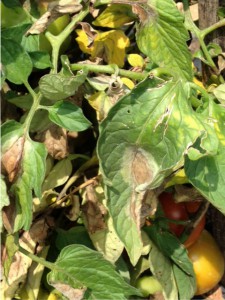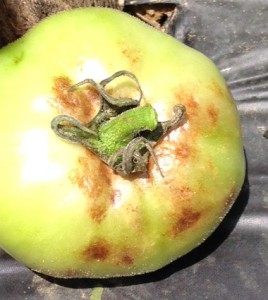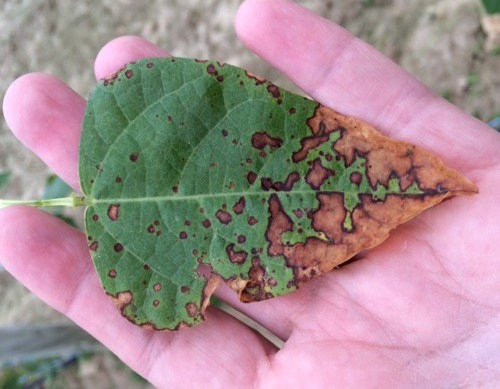Cucurbit downy mildew has been found on cucumber in Southeastern Pennsylvania in Berks county. Cucurbit downy mildew has also been reported in cucumber in Western NY as well as Eastern MD and DE on watermelon this past week. Weather conditions in the region have been ideal for its development. All cucurbit growers who have not initiated a weekly protectant fungicide program should do so immediately and consider adding downy mildew specific fungicides. For more information on the control of downy mildew in cucurbit crops please see the 2015 Commercial Fungicide Recommendations Guide.
Archives for July 2015
Potato | Tomato Disease Forecast 7-7-15
Click to View | Download Report 7-7-15
Potato Disease Forecasting Report
We will be tracking DSVs for Late blight development and calculating P-days for initiating the first early blight fungicide application.
The first late blight fungicide application is recommended once 18 DSVs accumulate from green row. Green row typically occurs around the first week in May in southern New Jersey. An early season application of a protectant fungicide such as mancozeb (Dithane, Manzate, Penncozeb) or Bravo (chlorothalonil) as soon the field is accessible is suggested. Please be vigilant and keep a look out for suspect late blight infections on young plants. No late blight has been reported in our region to date.
Remember the threshold for P-days is 300! Once 300 P-days is reached for your location early blight fungicide applications should be initiated. Growers who are interested in using this model should chose the location above that is closest in proximity to their farming operation and should regularly check the Cornell NEWA website (http://newa.cornell.edu/) where this information is compiled from. Click on Pests Forecasts from the menu, select your weather station, and click on tomato diseases, set accumulation start date and a table of daily and total DSVs will be generated.
Disease severity values (DSVs) for early blight, septoria leaf spot, and tomato anthracnose development are determined daily based on leaf wetness (due to rainfall, dew) and air temperature.
On a daily basis DSV values can range from 0 to 4 where 0 = no chance for disease development to 4 = high chance for disease development.
DSVs are accumulated during the production season.Fungicide applications are based on an individually determined DSV threshold. The first fungicide application for the control of these three diseases is not warranted until 35 DSVs have accumulated from your transplanting date. After that, growers can base fungicide applications on different DSV thresholds.
Late blight found on tomato in New Jersey – ALERT – 7-6-15
Late blight (US-23) has been found on two tomato fields near Chester and Long Valley in Morris County, New Jersey. This is the first report of late blight in the state and region to date. All tomato (and potato) growers should immediately scout their fields looking for the diagnostic symptoms of the disease on leaves (Fig. 1) and/or fruit (Fig. 2). Tomato growers (and potato) who have not initiated a regular weekly protectant fungicide program should do so. The prolonged, wet weather we have experienced and are expected to have this week are ideal conditions for late blight development. For more information on the control of late blight on tomato and potato please see the 2015 Commercial Fungicide Recommendations Guide.

Late blight on tomato leaves.

Late blight on green tomato fruit.
Bacterial Brown Spot of Lima Bean
Bacterial brown spot (Pseudomonas syringae pv. syringae) was found on lima bean in southern New Jersey this past week. Bacterial brown spot is unusual and tends to show up under prolonged wet conditions. The bacterium is spread from the soil to the lower canopy by splashing rain and wind. Working in fields and cultivating during wet conditions can also help spread the bacterium. The symptoms that develop on the leaves look similar to a fungal infection. Copper applications may help to suppress the spread of the disease.

Bacterial brown spot of lima bean. Symptoms look like a fungal infection.
(Photo by Michelle Infante-Casella)
Vegetable Disease Briefs – 7/4/15
- Cucurbit downy mildew has been reported as far north as Eastern Maryland and southern Delaware on watermelon. It was also reported on cucumber in Ohio this past week. All cucurbit growers should scout on a regular basis and consider including downy mildew specific fungicide(s) to their weekly maintenance programs. Wet weather is predicted every day this upcoming week making conditions ideal for downy mildew development around the state and region. For more information on the control of downy mildew on specific cucurbit crops please see the 2015 Commercial Fungicides Recommendations Guide. To track the progress of CDM in the US please visit http://cdm.ipmpipe.org/
- Bacterial brown spot has been reported on lima bean in southern New Jersey.
- Anthracnose has been reported on snap bean in southern New Jersey.
- Phytophthora blight on pepper and cucurbit crops have been reported. The heavy rains that have been around lately have been ideal for P. capsici development. All growers need to scout on a regular basis and applied preventative fungicides on a regular basis as well as remain proactive by removing infected plants from field, making sure water is able to drain away from beds/fields, and cutting plastic to help dry out beds.
- A new, more aggressive form of Black leg has been reported in potato in southern New Jersey.
- Bacterial leaf spot is being reported on pepper and tomato.
- Basil downy mildew remains active. All basil growers should continue to scout and be proactive.
- Late blight has been reported on potato as far north as North Carolina near the Virginia border. There have been no reports of late blight in the region to date. To track late blight in the US please visit http://usablight.org/
Potato | Tomato Disease Forecast 7-4-15
Click to View | Download Report 7-4-15
Potato Disease Forecasting Report
We will be tracking DSVs for Late blight development and calculating P-days for initiating the first early blight fungicide application.
The first late blight fungicide application is recommended once 18 DSVs accumulate from green row. Green row typically occurs around the first week in May in southern New Jersey. An early season application of a protectant fungicide such as mancozeb (Dithane, Manzate, Penncozeb) or Bravo (chlorothalonil) as soon the field is accessible is suggested. Please be vigilant and keep a look out for suspect late blight infections on young plants. No late blight has been reported in our region to date.
Remember the threshold for P-days is 300! Once 300 P-days is reached for your location early blight fungicide applications should be initiated. Growers who are interested in using this model should chose the location above that is closest in proximity to their farming operation and should regularly check the Cornell NEWA website (http://newa.cornell.edu/) where this information is compiled from. Click on Pests Forecasts from the menu, select your weather station, and click on tomato diseases, set accumulation start date and a table of daily and total DSVs will be generated.
Disease severity values (DSVs) for early blight, septoria leaf spot, and tomato anthracnose development are determined daily based on leaf wetness (due to rainfall, dew) and air temperature.
On a daily basis DSV values can range from 0 to 4 where 0 = no chance for disease development to 4 = high chance for disease development.
DSVs are accumulated during the production season.Fungicide applications are based on an individually determined DSV threshold. The first fungicide application for the control of these three diseases is not warranted until 35 DSVs have accumulated from your transplanting date. After that, growers can base fungicide applications on different DSV thresholds.
